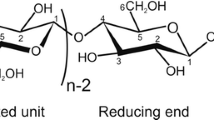Summary
By a double colchicine treatment the nerve-cell population ofhydra was reduced to less than 1% of the normal complement. Such severely nerve-depletedhydra contained normal or higher than normal concentrations of head activator, head inhibitor, foot activator and foot inhibitor which in normal animals are produced by nerve cells. According to typical chromatographic properties all four morphogenetic substances were chemically identical to those found in normal animals. It is suggested that in nervedepletedhydra the epithelial cells, as the only remaining cell type, have taken over the morphogen-producing function of nerve cells.
Similar content being viewed by others
References
Berking, S.: Bud formation inhydra: Inhibition by an endogenous morphogen. Wilhelm Roux' Arch. Entwicklungsmech. Org.181, 215–225 (1977)
Bode, H., Berking, S., David, C.N., Gierer, A., Schaller, H.C., Trenkner, E.: Quantitative analysis of cell types during growth and morphogenesis inhydra. Wilhelm Roux' Arch. Entwicklungsmech. Org.171, 269–285 (1973)
Campbell, R.D.: Elimination ofhydra interstitial and nerve cells by means of colchicine. J. Cell Sci21, 1–13 (1976)
David, C.N.: A quantitative method for maceration of hydra tissue. Wilhelm Roux' Arch. Entwicklungsmech. Org.171, 259–268 (1973)
Grimmelikhuijzen C.J.P., Schaller, H.C.: Isolation of a substance activating foot formation in hydra. Cell Differ.6, 297–305 (1977)
Grimmelikhuijzen, C.J.P.: Properties of the foot activator fromhydra. Cell Differ.8, 267–273 (1979)
Marcum, B.A., Campbell, R.D.: Development ofhydra lacking nerve and interstitial cells. J. Cell Sci.29, 17–33 (1978)
Marcum, B.A., Campbell, R.D., Romero, J.: Polarity reversal in nerve-freehydra. Science197, 771–773 (1977)
Schaller, H.C.: Isolation and characterization of a low-molecular weight substance activating head and bud formation inhydra. J. Embryol. Exp. Morphol.29, 27–38 (1973)
Schaller, H.C., Gierer, A.: Distribution of the head-activating substance inhydra and its localization in membranous particles in nerve cells. J. Embryol. Exp. Morphol.29, 39–52 (1973)
Schaller, H.C., Schmidt, T., Grimmelikhuijzen, C.J.P.: Separation and specificity of action of four morphogens fromhydra. Wilhelm Roux' Arch. Entwicklungsmech. Org.186, 139–149 (1979)
Schmidt, T.: Nachweis, Isolierung und Charakterisierung eines fußinhibierenden Morphogens inHydra. University of Heidelberg: Ph. D. Thesis (1979)
Schmidt, T., Schaller, H.C.: Evidence for a foot-inhibiting substance inhydra. Cell Differ5, 151–159 (1976)
Sugiyama, T., Fujisawa, T.: Genetic analysis of developmental mechanisms inhydra. II. Isolation and characterization of an interstitial cell-deficient strain. J. Cell Sci.29, 35–52 (1978)
Author information
Authors and Affiliations
Rights and permissions
About this article
Cite this article
Schaller, H.C., Grimmelikhuijzen, C.J.P., Schmidt, T. et al. Morphogenetic substances in nerve-depletedhydra . Wilhelm Roux' Archiv 187, 323–328 (1979). https://doi.org/10.1007/BF00848467
Received:
Accepted:
Issue Date:
DOI: https://doi.org/10.1007/BF00848467




